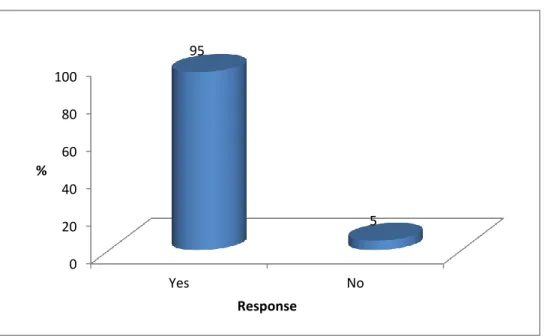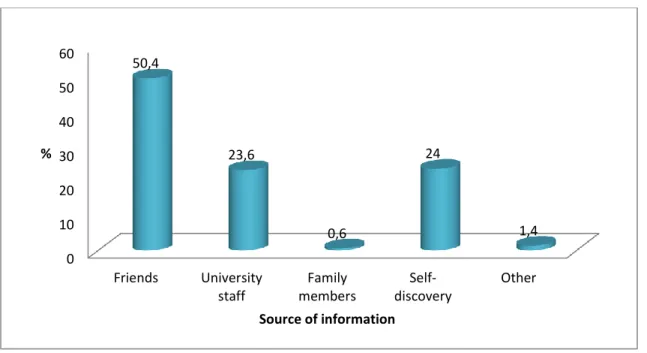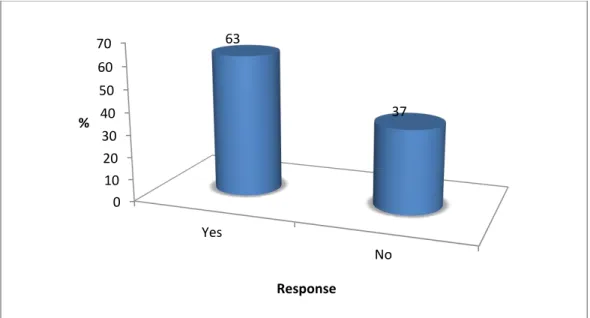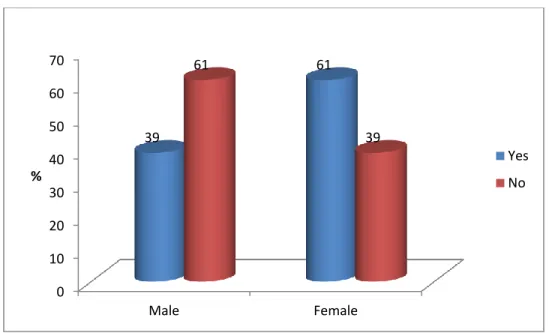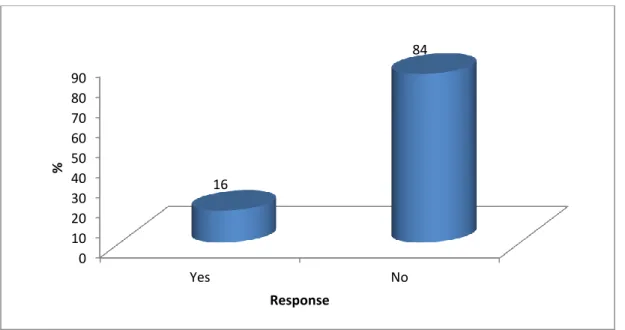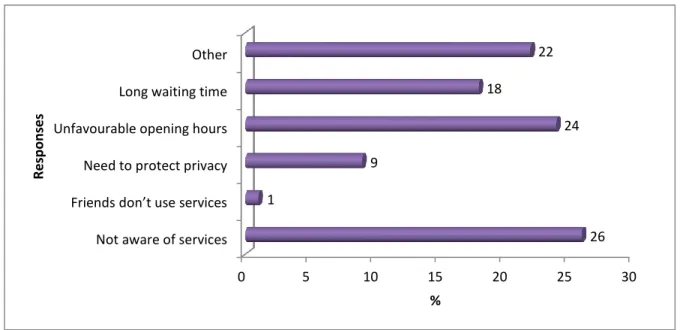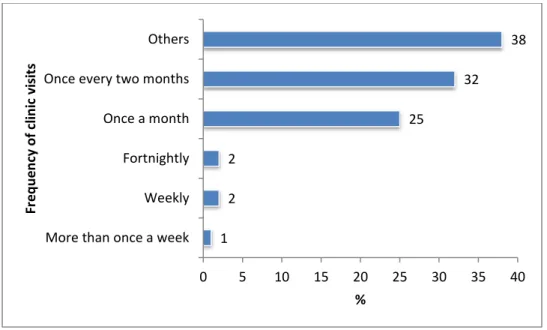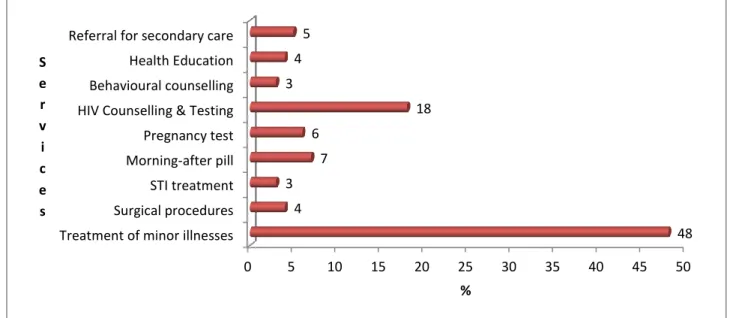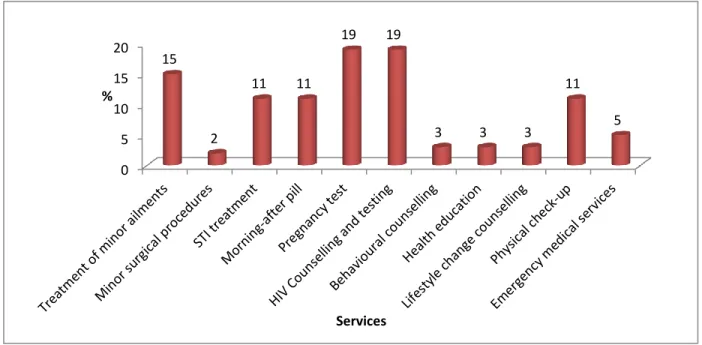INTRODUCTION
Background to the study…
Similarly, as many as twenty percent of students in an American college were ignorant of campus mental health services. Female undergraduate students in Lesotho identified barriers to accessing campus contraceptive services, which included health center location, inconvenient opening hours and judgmental attitudes of providers (Akintade, Pengpid & Peltzer, 2011).
Statement of the problem
Rationale of the study
Significance of the study
Aim
Objectives
For example, the services at the clinic are tailored to the students' specific needs. The interaction between the hours of service of the health facilities (system factors) and the times when the individual wants services to be available (individual factors). Less than a fifth (62, 19%) of respondents rated the service they received at the clinic as.
Some of the respondents expressed satisfaction with the quality of services currently provided at the clinic. There was also low awareness of the range of services offered at the campus health centre. Barriers to and facilitators of the delivery of a youth-friendly health service program in rural South Africa.
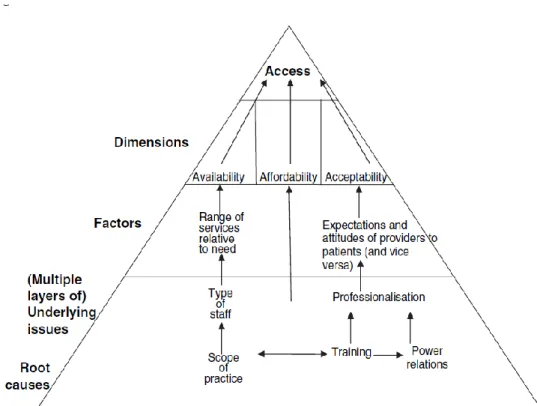
Conceptual and operational definition of terms
LITERATURE REVIEW
Introduction
This chapter presents a review of the data and conceptual literature related to the concept of access. Data-driven literature reviewed the literature on students' level of awareness of health services, barriers to availability of health services, and barriers to acceptance of health services.
Data based literature
- Global Burden of Disease on Young People
- Burden of Disease on Young People in Africa
- Burden of Disease on Young People in South Africa…
- WHO Guidelines for Youth Friendly services
- Modes of delivery of Youth Friendly services
- Characteristics of Ideal Youth Friendly services
- Barriers to Accessing health services
- Awareness barriers to campus health services…
- Availability barriers to campus health services.…
- Acceptability barriers to campus health services…
The provision of health services to young people has been of interest in the recent past. The judgmental attitude of health providers towards young people was a barrier to the use of sexual and reproductive health services.
Conceptual based literature
Definitions of Access
Access can therefore be seen as the interplay of factors between individuals and the health system. It has been described as the 'degree of agreement' between individuals and the health system (McIntyre et al., 2009).
Dimensions of Access
- Availability
- Acceptability
- Affordability
The model showed no significant relationship between level of study, location of the clinic and POCHS. Although the majority of respondents were aware of the availability of health services on campus, only 63% made use of these services. Sixty-one percent of the respondents who used the UNIVEN health services were female while only 39% were male.
This survey showed that about a third of the respondents (30%) found the opening times inconvenient. There was little knowledge of the various services provided at the Univen health centre. Which of the following services are you aware of that are available at the UNIVEN Health Center.
RESEARCH METHODOLOGY
Introduction
This chapter explains the methodology of the study, which includes study design, study setting, population and sampling, the instrument that will be used to collect data, measures to ensure the validity and reliability of the study, data collection and analysis, and the ethical aspect.
Study design
Study setting
Services provided at the center include treatment of common conditions, emergency contraception, lifestyle and behavior counseling, and HIV counseling and testing.
Study population and sampling
Target population
Sampling
- Sampling size
- Sampling of rooms
- Inclusion and Exclusion Criteria
Therefore, F5 housing constitutes 5.96% of the sample size for the survey and this gave a total of 26 rooms and systematic sampling was used to select the exact rooms from which to select the F5 respondents. Exclusion criteria: People who were not legal residents of the room were not selected in the sample, regardless of study level and age.
Measurement Instrument
For example, dormitory F5 has a total of 129 female-only beds and this represents 5.96% of the total number of beds (sample population) in the school. Part B assesses the level of students' awareness of the services provided by the University Health Center.
Pre-test
Section C focuses on the accessibility barriers that the students experience in connection with access to institutional health services. Section D contains information on barriers to acceptance that the students experience in connection with access to institutional health services.
Data Collection…
Data Analysis
Validity and Reliability of the study
Validity
Reliability
Ethical consideration…
Permission to conduct the study…
Informed consent
Confidentiality and Anonymity
Dissemination of results
Respondents were also provided with a list of the services provided at the clinic and asked to tick those they were aware of. Policy makers and stakeholders should design interventions aimed at improving male students' use of the clinic services. Recruiting more staff and ensuring more effective organization of the health delivery system to reduce waiting times at the clinic.
These include low awareness of available services, inconvenient clinic opening hours and long waiting times before treatment at the clinic. These barriers contribute to the low utilization of campus health services and can negatively impact student educational outcomes if not addressed urgently. S., 2010.Adolescent-friendly reproductive health services in Jordan from the youth's perspective: a descriptive qualitative study.
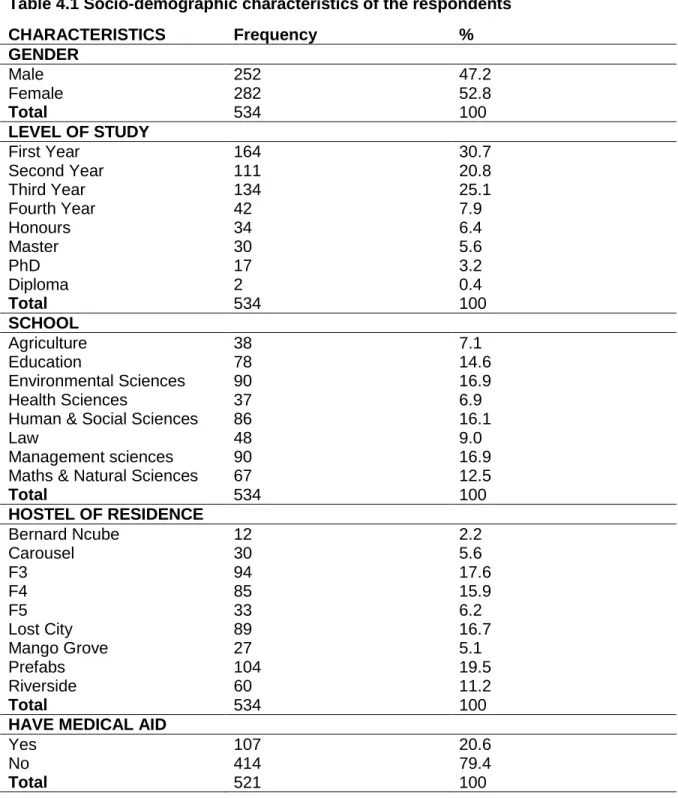
PRESENTATION OF STUDY FINDINGS
Introduction
The majority of respondents (n) answered that they did not need clinic services, while only 10% needed services and did not receive them (Figure 4.10). Respondents were asked to make suggestions about what they thought could be done to improving the quality of services provided at the clinic This study found that only about half (56%) of the students felt that the health workers at the clinic were adequately trained to manage the health challenges they had during their visit.
These include low awareness of the services available in the clinic, low clinic occupancy rates, especially by male students, unsatisfactory wait times and inconvenient clinic hours. This chapter summarizes the research, draws conclusions, and then proposes recommendations that may help overcome barriers to accessing UNIVEN's on-campus health services.
Section 1: Socio-demographic characteristics of respondents
Section 2: Level of awareness of respondents
Section 3: Availability barriers to campus health services
Barriers to the availability of health services on campus were assessed by asking respondents questions such as: "Did you need the services of the clinic and did not receive them?", "Is the location of the clinic convenient for you?", "Are the hours of operation suitable for village?” and “what do you think about the waiting time before consultation in the outpatient clinic?” The reasons that the respondents considered the location inappropriate were that the location of the clinic is far from their residence or lecture halls.
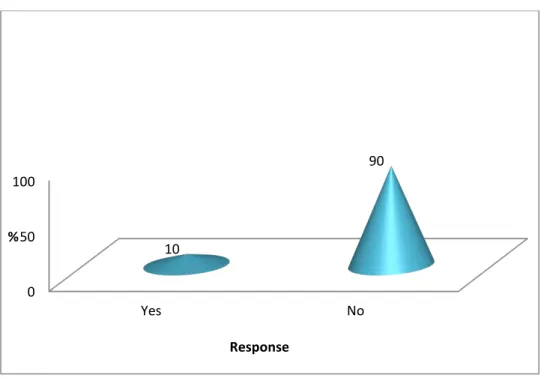
Section 4: Acceptability barriers to campus health services
This may be due to the fact that women are more likely to be concerned about the privacy and confidentiality of the health facility, especially when seeking sexual health services.
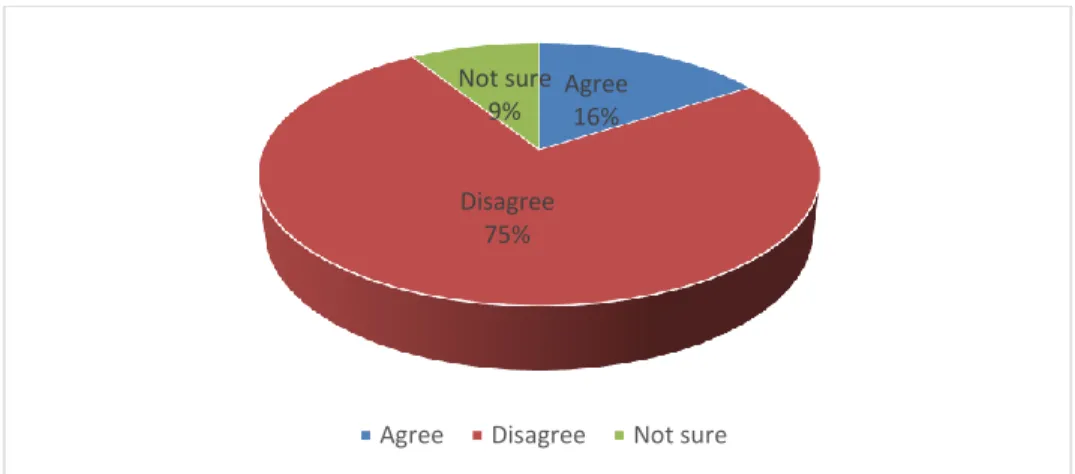
Respondents’ suggestions to improve services
Association between selected variables
- Association between gender and use of services
- Association between having medical insurance and use of services
- Association between gender and not receiving care when needed…
- Association between gender and availability barriers at the clinic
- Association between gender and acceptability barriers at the clinic
There was no significant relationship between having medical insurance and using campus health services (chi-square = 2.936, p = 0.569) as shown in Table 4.3. There was a significant relationship between gender perception of clinic waiting time (chi-square = 19.025, p = 0.000) and whether health providers were considered capable of managing patient complaints at the time of their visit (chi-square = 10.433, p = 0.034) as shown in table 4.5.

Modelling
Relationship between POCHS and independent variables
Model presentation
The survey found that women were more likely to use UNIVEN's health services than men. Similarly, 17% of students in a New Zealand study reported needing health services and not receiving them (Denny, Farrant, Cosgriff, Hart, Cameron, Johnson, McNair, Utter, Crengle, Fleming, Ameratunga, Sheridan & Robinson , 2012). Overall, the study revealed that University of Venda students face some barriers in accessing campus health services.
When and why young people in the UK use sexual health services for the first time.
DISCUSSION
Introduction
Socio-demographic characteristics
Awareness barriers to campus health services
The result of this study is lower than that reported by Njagi and Maharaj (2006) study where 53% of students at the University of KwaZulu-Natal in South Africa were aware of HIV counseling and testing services on campus. The results of this study are comparable to those reported in an American study in which 65% of students were reported to have access to school health services, with the majority of users being female (Juszczak, Melinkovich & Kaplan, 2003).
Availability barriers to campus health services
School health services are no longer available to students when clinic hours coincide with class hours. However, the finding of the current study is lower than that reported by an Ethiopian study that found that as many as 70% of students believed that opening hours were a major barrier to accessing on-campus health services (Cherie & Berhane, 2012).
Acceptability barriers to campus health services
Research on barriers to accessing campus health services in other university campuses in South Africa should be encouraged to assist policy formulation in addressing these barriers. Adolescents' attitudes and preferences for sexual and reproductive health services in Burkina Faso, Ghana, Malawi and Uganda. Sexually Transmitted Infections Knowledge and Barriers to Seeking Health Services Among High School Adolescents in Addis Ababa, Ethiopia.
Barriers to sexual health services for youth in Nepal. Journal of Health, Population and Nutrition, 28(6), pp. 618-627.
Predictors of preferences for off-campus health services
Conclusions
SUMMARY, CONCLUSIONS AND RECOMMENDATIONS
Introduction
Summary
Clinic opening hours were seen by many students as a barrier to accessing services. Many students expressed their preference for the clinic to be open after school hours and during weekends.
Limitations of the study
There was a high level of disapproval of the waiting times at the clinic with many students regarding the length of time they waited to receive treatment at the clinic as 'too long'. The reasons given for preferring to use traditional health facilities include long waiting times, inconvenient opening hours and concerns about confidentiality.
Conclusions
Furthermore, the study revealed that most UNIVEN students do not experience acceptable barriers related to concerns about confidentiality, privacy in the consultation room, and respectful treatment from campus health providers. Most students did not express a preference for same-sex providers as seen in similar studies in other parts of the world.
Recommendations
This has been a barrier for some students, especially women who need emergency contraception during weekends when the clinic is usually closed. In contrast, the strategic location of the clinic between the student residences and the lecture halls was found to be a facilitator for the use of the clinic as most students found the location ideal.
Suggestions for further research
Interpersonal relationships between health professionals and young clients: Barriers to accessing sexual and reproductive health care. Does making reproductive health clinical services more youth-friendly increases adolescent use of services. Willingness of young people in rural Ethiopia to seek health services for sexually transmitted infections. African Journal of AIDS Research, 8(2), pp.135-146.
To address this issue, it is necessary to know the barriers faced by UNIVEN students in accessing the health services of the institution.
MEASUREMENT INSTRUMENT
What do you suggest should be done to improve the quality of services provided at the clinic? The study is important as the research hopes that the outcome of the study will help improve the quality of health service delivery at the UNIVEN Health Center.
INFORMATION SHEET
CONSENT FORM
I understand that my participation is voluntary and that I can withdraw from the study at any time without any negative impact on my life or health.
ETHICAL CLEARANCE LETTER
PERMISSION TO CONDUCT STUDY
EDITOR’S LETTER
